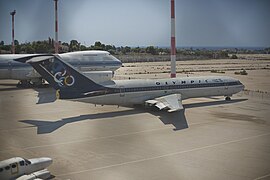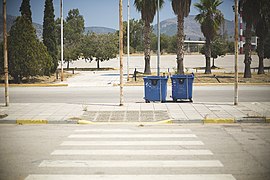Athens-Ellinikon Airport
| Athens-Ellinikon Airport Κρατικός Αερολιμένας Αθηνών |
|
|---|---|

|
|
| Characteristics | |
| ICAO code | LGAT |
| IATA code | ATH |
| Coordinates | |
| Height above MSL | 21 m (69 ft ) |
| Transport links | |
| Distance from the city center | 7 km south of Athens |
| Street |
|
| Local transport | Athens tram |
| Basic data | |
| opening | 1938 |
| closure | April 28, 2001 |
| Terminals | 2 |
| Passengers | 12 million |
| Runways | |
| 15L / 33R | 3500 m × 60 m asphalt |
| 15R / 33L | 3148 m × 45 m asphalt |
The Ellinikon International Airport ( Greek Κρατικός Αερολιμένας Αθηνών ) was from 1938 to 2001, the international commercial airport of the Greek capital Athens . It was replaced and closed by the new Athens-Eleftherios Venizelos airport .
Location and transport links
The airport is located in the suburb of Elliniko on the coast, in the immediate vicinity of the popular suburbs Glyfada and Voula, about seven kilometers south of downtown Athens. The area is accessible by the Athens tram and an expressway.
history
The airport originally replaced the Dekeleia airfield . All flights were initially handled at the West Terminal, which was later only used by Olympic Airlines . Between 1966 and 1970, the East Terminal was built, where all flights by international airlines were handled. The building is a design by the Finnish star architect Eero Saarinen and is now a listed building. The west terminal was expanded in the 1970s, and the new tower was built in the 1990s.
On August 5, 1973, the two Palestinian militants Talaat Hussein Abdallah and Zemed Mohammed Ahmed, armed with submachine guns and hand grenades, who identified themselves as members of the terrorist organization Black September , opened fire on a passenger lounge at the airport, killing three people and 55 were wounded.
On April 28, 2001 the airport was closed and replaced by the new Athens-Eleftherios Venizelos airport . Both terminals and their parking spaces have been fenced in and are no longer open to the public except for events today. The original plan was to demolish the entire structure and turn it into a park. Competition drafts provided for a partial preservation of the aeronautical infrastructure and monument preservers managed to protect the Saarinen building.
After the closure
The non-profit cultural association of the employees of Olympic Airways ΠΟΛ.Κ.Ε.Ο.Α. tries to set up a museum on the site. However, this initiative is rejected by the state with reference to a similar facility of the air force at the Dekelia airfield.
The club acquired three aircraft that had been taken out of service by Olympic. These are a Boeing 747 (SX-OAB "Olympic Eagle", Sn: 20825/223), a Boeing 737 (SX-BCA "Apollo", Sn 21224/463) and a Boeing 727 (SX-CBA "Mt . Olympus ", Sn 20003/671). The association has been operating a small museum on a corner of the West Terminal since 2009, at this point the building is still open to the public, the aircraft are parked at the East Terminal and are currently not accessible.
For the 2004 Summer Olympics , part of the site was converted into the Elliniko Olympic Complex , around two baseball stadiums were built and many hangars were converted into sports halls.
As temporary use, trade fairs and congresses are also held in the clearance halls. A hangar was converted into a tram depot. To date, have air traffic control and the National Weather Service Εθνική Μετεωρολογική Υπηρεσία Ethniki Meteorologiki Iperesia on the site of its headquarters. A feasibility study looked at an extension of Line 2 of the Athens Metro to the center.
In 2016 , up to over 3,500 refugees were housed in the airport building and around the airport in the adjacent hockey and baseball stadiums, some in tents. At the beginning of May 2016, 1,000 refugees went on hunger strike because of inadequate care, lack of infrastructure and clean water. The Greek government had announced the evacuation of Ellinikos by July 20; the deputy mayor of Athens responsible for migration, Lefteris Papagiannakis, said in August the evacuation would probably last until the end of the year. Due to deficiencies in the sewage system, basements are flooded with sewage. At the end of August it was reported that experts from the Center for Disease Control and Prevention (KEELPNO) and the local medical association were warning of extreme health hazards and that infectious diseases were increasing.
Future use
Since around 2014 there has been discussion of building a tourist resort on the airport site . In September 2016, according to various press reports, the sale to a consortium of Greek, Chinese and Arab investors was decided. It should u. a. a casino and a luxurious holiday complex are being built, around 8 billion euros will be invested and several thousand new jobs will be created.
Incidents
- On October 26, 1947, a Douglas DC-4 from the Swedish AB Aerotransport (SE-BBG) flew into the western flank of Mount Hymettos near Athens. The machine was on a flight from Istanbul via Athens, Rome, Geneva and Copenhagen to Stockholm and was approaching the then Athens-Hassani airport. All 44 people on board were killed, 8 crew members and 36 passengers.
- On 21 October 1972, a was NAMC YS-11 of Olympic Airways (SX-BBQ) , flew into the sea off the coast of Voula, Athens. Of the 53 occupants, 36 passengers and one crew member died, 13 passengers and three crew members were rescued. The accident was a controlled flight into terrain .
- On September 8 In 1974, on a flight of a Boeing 707-331B of Trans World Airlines from the airport Athens Hellinikon to Rome Fiumicino a bomb explosion in the rear cargo space the machine to crash. The plane crashed 93 km west of Kefalonia in the Mediterranean Sea, killing all 88 people on board. Two weeks earlier there had been an attempted attack on the same flight.
- On October 7, 1979 began at 22:15 local time one of Geneva next Douglas DC-8-62 of the airline Swissair (SR flight 316 air vehicle registration HB-IDE) is only 740 meters behind the displaced threshold of runway 15L at excessive speed of around 149 knots and did not come to a stop on the remaining 2240 meters due to improper use of the braking systems. The machine rolled over the end of the runway at about 40 knots, broke through an airport fence and crashed into a road four meters below. 14 passengers suffered fatal burns as a result of the fire that broke out. Of the 154 people on board, 140 (including the ten-man crew) survived the accident. It was raining lightly during the accident; At the request of the Swissair captain, the tower indicated the braking effect as "medium to poor". After touching down, the braking effect was initially good, but then decreased rapidly. There were also 40 containers with radioactive material for medical use on board, most of which were destroyed by the fire. According to experts from the Greek atomic center, however, no radioactive material escaped into the atmosphere (see also Swissair flight 316 ) .
- On April 2, 1986, a Trans World Airlines (TWA) (N54340) Boeing 727-231 exploded during the flight from Rome-Fiumicino to Athens-Ellinikon Airport , a bomb placed by the Palestinian terrorist group Abu Nidal Organization . A hole was created in the fuselage through which four passengers were sucked out and perished. Nevertheless, the aircraft landed safely in Athens and was later repaired (see also Trans-World Airlines flight 840 ) .
gallery
A decommissioned Boeing 727 "Mt. Olympus" of the former Olympic Airlines at the east terminal of Ellinikon.
A sign to the departure building on the former international Ellinikon
Bus terminal with the listed reception building of the former Ellinikon International Airport in Athens, which can be seen in the background .
One of the many dogs roaming around in and around Athens , here at the reception building of the former Athens-Ellinikon international airport.
Web links
Individual evidence
- ↑ BBC ON THIS DAY - August 5, 1973: Athens attack leaves three dead. In: BBC News . British Broadcasting Corporation , accessed September 23, 2017 .
- ↑ Μουσείο Αεροπορίας. In: Πολιτιστικό Κέντρο Εργαζομένων Πολιτικής Αεροπορίας. Πολιτιστικό Κέντρο Εργαζομένων Ολυμπιακής Αεροπορίας (ΠΟΛ.Κ.Ε.Ο.Α.), accessed on September 22, 2017 (Greek).
- ↑ Athens camps threatened with a “health bomb”: precarious conditions at the ex-airport. In: news.ORF.at. Österreichischer Rundfunk , August 31, 2016, accessed on September 23, 2017 .
- ↑ Stefan Schultz: Athens old airport: plans for a tourist resort. In: spiegel.de. Spiegel Online , July 27, 2014, accessed September 23, 2017 .
- ↑ Åke Hall: Luftens Vikingar - en bok om SAS alla flygplan . Air Historic Research, Nässjö 2002, ISBN 91-973892-3-4 , p. 11. (Swedish) .
- ^ Accident report DC-4 SE-BBG , Aviation Safety Network (English), accessed on December 3, 2017.
- ^ Accident report YS-11 SX-BBQ , Aviation Safety Network (English), accessed on August 25, 2017.
- ↑ Flight accident data and report TWA, Boeing 707, September 8, 1974 in the Aviation Safety Network (English)
- ↑ Aircraft accident investigation report of the Greek investigation commission (set up by the civil aviation authority of Greece) on the accident of the airplane Mc Donnell Douglas DC-8-62, HB-IDE of Swissair, Switzerland. Luftverkehr AG dated October 7, 1979 at Athens Airport, Greece. Federal Transport and Energy Department, No. 1979 / A 1 - 992
- ↑ Aircraft accident data and report of the Swissair accident on October 7, 1979 in the Aviation Safety Network (English), accessed on September 23, 2017.
- ^ ICAO Accident Summary 1979, CA 25, pp. 31/79
- ↑ Aircraft accident data and report B-727-200 N54340 in the Aviation Safety Network (English), accessed on February 6, 2019.





